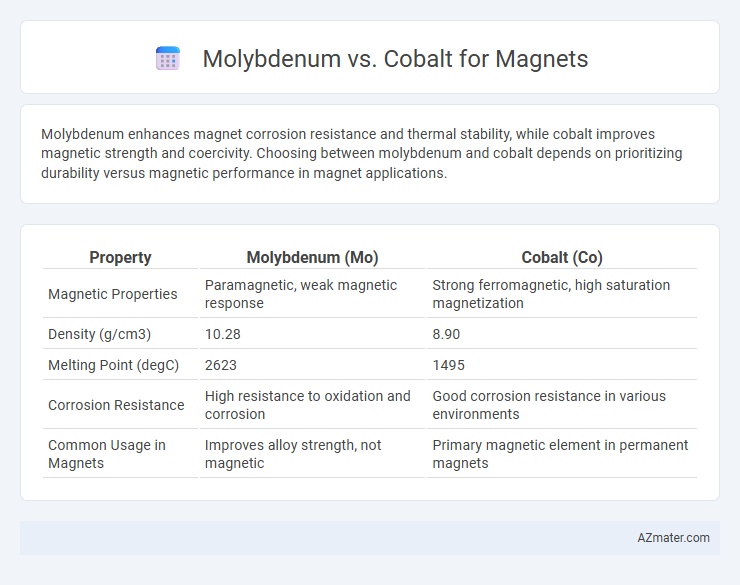Molybdenum enhances magnet corrosion resistance and thermal stability, while cobalt improves magnetic strength and coercivity. Choosing between molybdenum and cobalt depends on prioritizing durability versus magnetic performance in magnet applications.
Table of Comparison
| Property | Molybdenum (Mo) | Cobalt (Co) |
|---|---|---|
| Magnetic Properties | Paramagnetic, weak magnetic response | Strong ferromagnetic, high saturation magnetization |
| Density (g/cm3) | 10.28 | 8.90 |
| Melting Point (degC) | 2623 | 1495 |
| Corrosion Resistance | High resistance to oxidation and corrosion | Good corrosion resistance in various environments |
| Common Usage in Magnets | Improves alloy strength, not magnetic | Primary magnetic element in permanent magnets |
Introduction to Molybdenum and Cobalt in Magnet Technology
Molybdenum and cobalt are critical elements in magnet technology due to their unique magnetic and structural properties. Cobalt offers high magnetic strength and thermal stability, making it ideal for permanent magnets used in electric motors and aerospace applications. Molybdenum contributes to corrosion resistance and enhanced mechanical strength when alloyed with magnetic materials, improving the durability and performance of magnets in harsh environments.
Chemical Properties and Composition
Molybdenum exhibits high melting points and excellent corrosion resistance, making it ideal for enhancing magnet durability and thermal stability, while its atomic number 42 and electron configuration [Kr] 4d^5 5s^1 contribute to its strong metallic bonding. Cobalt, with atomic number 27 and electron configuration [Ar] 3d^7 4s^2, is ferromagnetic at room temperature, providing superior magnetic strength and coercivity due to its ability to retain magnetic domains. The chemical composition of molybdenum alloys often increases hardness and structural integrity, whereas cobalt-based magnets, such as samarium-cobalt, optimize magnetic performance through intrinsic ferromagnetism and resistance to oxidation.
Magnetic Properties: Strength and Performance
Molybdenum enhances magnets primarily as an alloying element that improves corrosion resistance and thermal stability without significantly increasing magnetic strength. Cobalt, in contrast, is a key component in high-performance magnets like Alnico and samarium-cobalt, offering superior magnetic strength and high-temperature stability. Magnets containing cobalt generally exhibit higher coercivity and energy product values, resulting in stronger magnetic performance compared to molybdenum-based alternatives.
Thermal Stability and Resistance
Molybdenum exhibits superior thermal stability compared to cobalt, maintaining its magnetic properties at elevated temperatures up to around 1,000degC, making it ideal for high-temperature magnet applications. Cobalt, while having excellent magnetic strength and corrosion resistance, tends to experience reduced performance above 600degC due to lower thermal resistance. The higher melting point and oxidation resistance of molybdenum contribute to enhanced durability in extreme thermal environments, crucial for industrial magnets used in high-heat settings.
Corrosion Resistance Comparison
Molybdenum exhibits superior corrosion resistance compared to cobalt, especially in acidic and chloride-rich environments, making it highly effective in magnet applications exposed to harsh conditions. Cobalt, while offering good magnetic properties, is more prone to oxidation and degradation over time when subjected to corrosive media. Incorporating molybdenum into cobalt-based magnets can significantly enhance their durability and lifespan by improving resistance to rust and chemical attack.
Cost and Availability Factors
Molybdenum offers a lower cost alternative to cobalt for magnet production due to its greater abundance in the Earth's crust, leading to more stable supply chains and reduced price volatility. Cobalt, being rarer and primarily sourced from geopolitically sensitive regions, tends to have higher costs and supply risks, impacting overall magnet manufacturing expenses. The widespread availability of molybdenum supports scalable production, making it a more economically viable option in cost-sensitive magnet applications.
Applications in Modern Magnet Production
Molybdenum and cobalt play critical roles in modern magnet production, with cobalt being the primary element in high-performance rare-earth magnets such as samarium-cobalt (SmCo) magnets. Molybdenum is often used as an alloying element to enhance the corrosion resistance and mechanical strength of magnets, particularly in sintered neodymium-iron-boron (NdFeB) magnets. The combination of cobalt's magnetic properties and molybdenum's durability makes them essential for applications in electric vehicles, aerospace, and renewable energy technologies.
Environmental Impact and Sustainability
Molybdenum offers a lower environmental footprint compared to cobalt due to its greater abundance and less intensive mining processes, resulting in reduced ecosystem disruption and carbon emissions. Cobalt extraction often involves significant ethical and environmental concerns, including habitat destruction, water pollution, and hazardous working conditions, raising sustainability challenges. Utilizing molybdenum-based magnets supports long-term resource availability and aligns better with sustainable material management practices in advanced manufacturing.
Recent Advances and Innovations
Recent advances in magnet technology reveal that molybdenum enhances coercivity and thermal stability in high-performance magnets, making it crucial for applications in electric vehicles and renewable energy systems. Innovations in cobalt-molybdenum alloys demonstrate improved magnetic anisotropy and corrosion resistance, boosting efficiency in compact magnetic devices. Research on nanostructured cobalt magnets doped with molybdenum shows significant enhancements in magnetic saturation and energy product, pushing the limits of miniaturized magnetic components.
Conclusion: Choosing the Right Metal for Magnets
Molybdenum offers superior corrosion resistance and thermal stability, making it ideal for high-temperature magnet applications, while cobalt provides exceptional magnetic strength and coercivity crucial for permanent magnets like samarium-cobalt alloys. The choice depends on the specific magnetic performance requirements and environmental conditions; molybdenum enhances durability and operational lifespan, whereas cobalt maximizes magnetic energy density. Selecting the right metal requires balancing thermal stability, corrosion resistance, and magnetic properties tailored to the intended magnet use.

Infographic: Molybdenum vs Cobalt for Magnet
 azmater.com
azmater.com